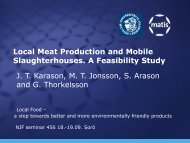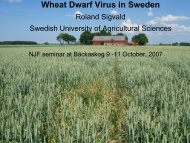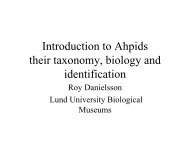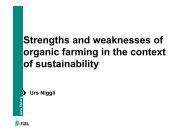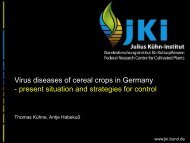measurement methods of soil, water, plant and fruit, in berry ... - NJF
measurement methods of soil, water, plant and fruit, in berry ... - NJF
measurement methods of soil, water, plant and fruit, in berry ... - NJF
You also want an ePaper? Increase the reach of your titles
YUMPU automatically turns print PDFs into web optimized ePapers that Google loves.
SAMPLING, ANALYSIS AND INTERPRETATION<br />
OF NUTRIENTS LEVELS IN APPLES<br />
Thomas Olsson<br />
AnalyCen Nordic AB<br />
Box 9024<br />
291 09 KRISTIANSTAD<br />
email thomas.olsson@analycen.se<br />
Background<br />
Knowledge <strong>of</strong> the nutrient status <strong>in</strong> apples dur<strong>in</strong>g different grow<strong>in</strong>g stages is <strong>of</strong> great<br />
importance s<strong>in</strong>ce it might answer questions regard<strong>in</strong>g malnutrition, fertilisation strategy<br />
sensory quality aspects <strong>and</strong> storability. S<strong>in</strong>ce the f<strong>in</strong>al amount <strong>of</strong> analysed sample is very<br />
small (few grams) much care must be taken on sampl<strong>in</strong>g <strong>and</strong> further subsampl<strong>in</strong>g.<br />
What parameters causes variation?<br />
Representative samples from a given field with one variety must <strong>in</strong>clude variations such as<br />
topography, <strong>soil</strong> chemistry, sunlight as well as <strong>water</strong> exposure. All these parameters will<br />
effect nutrient uptake <strong>and</strong> hence effect analytical results. Another approach is to sample<br />
different subfields with uniform conditions <strong>and</strong> analyse separately, unfortunately at higher<br />
analytical costs. If a field is very heterogeneous regard<strong>in</strong>g <strong>soil</strong> chemistry (ie different <strong>soil</strong><br />
types) this approach is how ever recommended.<br />
Number <strong>of</strong> <strong>in</strong>dividuals.<br />
The number <strong>of</strong> <strong>in</strong>dividuals is a compromise between statistical variations <strong>of</strong> nutrient content<br />
between <strong>in</strong>dividual apples <strong>and</strong> practical h<strong>and</strong>l<strong>in</strong>g <strong>of</strong> the samples regard<strong>in</strong>g transport <strong>and</strong><br />
analytical costs. At earlier grow<strong>in</strong>g stages (<strong>fruit</strong>lets) nutrient variation <strong>in</strong> <strong>in</strong>dividuals vary<br />
more than at more matured stages <strong>and</strong> hence greater number <strong>of</strong> <strong>in</strong>dividuals should be<br />
analysed. A commonly accepted role <strong>of</strong> thumb is 40 <strong>in</strong>dividuals for <strong>fruit</strong>lets <strong>and</strong> 20<br />
<strong>in</strong>dividuals for <strong>fruit</strong>s.<br />
Subsampl<strong>in</strong>g<br />
At the laboratory the sample has to be subsampled <strong>in</strong>to a smaller portion <strong>in</strong> order to be able to<br />
h<strong>and</strong>le it <strong>in</strong> the analytical equipment. From each <strong>in</strong>dividual two opposite slides will be taken<br />
<strong>and</strong> put <strong>in</strong> a blender. The slides will then be thoroughly mixed to homogeneous slurry. For<br />
apples with low <strong>water</strong> content <strong>water</strong> has to be added dur<strong>in</strong>g mix<strong>in</strong>g. The sample is then ready<br />
for further analysis.<br />
Digestion<br />
When analys<strong>in</strong>g for total content <strong>of</strong> nutrients organic matter has to be removed without any<br />
loss <strong>of</strong> nutrients. Different <strong>methods</strong> are used <strong>in</strong>volv<strong>in</strong>g dry ash<strong>in</strong>g, acid digestion, microwave<br />
supported acid digestion. We are us<strong>in</strong>g closed vessels microwave supported acid digestion.<br />
The method gives short digestion times <strong>and</strong> losses can be avoided. The amount <strong>of</strong> samples<br />
actually analysed is from 3 – 20 grams depend<strong>in</strong>g on method used.<br />
Measurement<br />
The f<strong>in</strong>al detection <strong>and</strong> quantification <strong>of</strong> the nutrients are carried out with means <strong>of</strong> ICP-<br />
OES, ICP-MS <strong>and</strong> for nitrogen automatic distillation.<br />
Uncerta<strong>in</strong>ty



